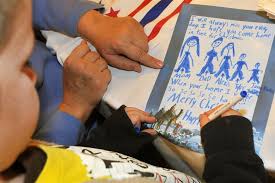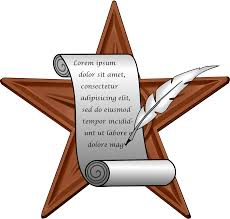- Provide meaningful and authentic writing opportunities for your child to draw (younger students)/write daily. Helping your child make the connection between writing and the real world will increase an interest in writing.

-
- Thank you notes
- Party invitations
- Letters to family members outside of the home
- Notes to family members inside the home
- Make grocery lists
- Create their own book or create a book together (Fold pieces of paper in half and staple them together). Have your child write a sentence/sentences under the drawings for a picture book
- Find a pen pal
- Meal plans or a menu/Directions for a recipe
- Have your child label their drawings (especially beginning writers)
- Create an “office” for your child. Gather different kinds of paper, envelopes, pencils and pens, crayons,
 stickers, and labels. Place them on a shelf near a desk or table or in a basket your child can carry to a comfortable place for writing. Add interesting and exciting items like address and date books, calendars, or an old computer keyboard.
stickers, and labels. Place them on a shelf near a desk or table or in a basket your child can carry to a comfortable place for writing. Add interesting and exciting items like address and date books, calendars, or an old computer keyboard. - Take it outside! Let your child write or draw with chalk or old paintbrushes and water on sidewalks and fences. Fill a backpack with writing tools and paper to take in the car or while doing errands.
- A Picture is Worth 1000 Words. Take pictures of an activity that is especially interesting to your child. Use them to write a story together. Take any photo saved on a phone or a tablet and have your child write about it. They can write about what happened that day, a descriptive piece about the setting or even a short story.
- Connect to your child’s interests. Think about your child’s favourite book series. Or maybe your child loves dinosaurs or horses etc. Whatever the interests, connect them to writing. Have your child write a new short story about a favourite character or let your child create a story all about dinosaurs, horses etc.
- Keep a portfolio of your child’s writing. At different times in the year, show your child their writing samples and comment on their progress.
- Celebrate your child’s writing by prominently hanging their work in places where it is visible to all. Knowing that writing is important will go a long way toward motivating your child to write more.

- Help your child publish their writing. Share your child’s writing with others or encourage your child to write for a kids’ magazines. When your child’s writing is published in a children’s book, your child will be on their way to becoming a lifelong writer and author. Check out this option for publishing children’s work: Stone Soup
For older writers:
- Regularly write in a Diary. Encourage your child to keep a diary or a journal using words and/or pictures.
- Descriptive writing. Help your child use interesting and descriptive words about different sights, smells, sounds, tastes and feelings. Some ideas include: the smell of dinner cooking in the house; the look of the sky at sunset/sunrise or during a thunderstorm; the feel of wet fur of a cat/dog; the sound of children playing outside; the taste of a popsicle on a warm summer day. Draw a picture of their image and describe the picture using ‘juicy’ words.
- Writing dialogue. Have your child to write a comic strip. Encourage your child to draw the comics and use speech bubbles. Encourage your child to describe the action and write the dialogue in the speech bubbles.
Read, read, read!
 One of the best activities to improve writing is reading. Reading exposes students to general vocabulary, word study and content-specific vocabulary. Through reading, students see a variety of authors’ techniques that they can use in their own writing.
One of the best activities to improve writing is reading. Reading exposes students to general vocabulary, word study and content-specific vocabulary. Through reading, students see a variety of authors’ techniques that they can use in their own writing.
Ask questions.
Always ask your child questions when he writes. Ask specific questions about your child’s writing such as: “How did that happen?” “How did that make you feel?” “Can you tell me more about that…?” “What are some other words you could use to describe…?”
Be a writing role model.
Make sure your child sees you as a writer. Point out times that you use writing to communicate with others. Whether  writing a shopping list, thank you note, or e-mail; completing an application; or ordering from a catalog, explain what you are doing. Ask your child what to add to the list or what to say in the thank you note or e-mail. Discuss authentic writing in the community such as articles and letters in the newspaper, on billboards or in written advertisements. Discuss the purpose of the writing and the target audience. When your child writes, you could write at the same time. You can schedule a day of the week that you will turn off the television and share your writing.
writing a shopping list, thank you note, or e-mail; completing an application; or ordering from a catalog, explain what you are doing. Ask your child what to add to the list or what to say in the thank you note or e-mail. Discuss authentic writing in the community such as articles and letters in the newspaper, on billboards or in written advertisements. Discuss the purpose of the writing and the target audience. When your child writes, you could write at the same time. You can schedule a day of the week that you will turn off the television and share your writing.
